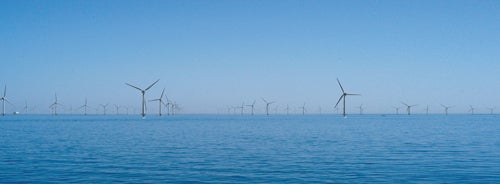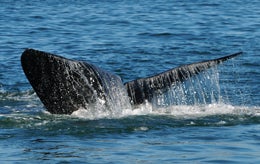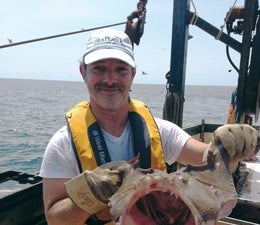Catching the Wind
 A rigorous URI-led effort has created a windfall for the state’s nascent offshore energy industry.
A rigorous URI-led effort has created a windfall for the state’s nascent offshore energy industry.
In 2006, Governor Donald Carcieri announced a project that was ambitious in its scope and its schedule: By 2010, the State of Rhode Island would generate 15 percent of the energy it needed from wind power. The goal’s audacity was not lost on anyone following the adventures of Jim Gordon, the Boston developer trying to build the nation’s first offshore wind farm in Nantucket Sound. Covering 24 square miles, the Cape Wind project proposed to build 130 wind turbines, projecting 440 feet above the waterline, capable of producing enough electricity to meet about 75 percent of the power needs for Cape Cod, Martha’s Vineyard and Nantucket Island.
Siting the turbines is any offshore wind project’s most critical decision—and Cape Wind’s location had immediately gathered a diverse, politically powerful and deep-pocketed enemy. The Alliance to Protect Nantucket Sound was one reason Gordon was limping through the permitting process. In the five years since Cape Wind had applied for its permits, the project had only obtained one state permit for the transmission cables and a favorable draft environmental impact statement from the U.S. Army Corps of Engineers. In the meantime, it fought off four lawsuits. Rhode Island officials were not eager to duplicate that experience. They haven’t. Today, Deepwater Wind’s 30-megawatt, five-turbine pilot wind farm three miles southeast of Block Island may well become the nation’s first offshore wind farm. The project is expected to connect New Shoreham to the grid, while generating 125,000 megawatts—and, by one consultant’s calculations, $100 million in economic activity and 200 jobs.
The unprecedented coming together of the University, the state and a renewable energy developer has drawn its share of admirers inside the Beltway, says U.S. Senator Sheldon Whitehouse:
“It shows that your state is a good place to do business.”
It began in 2007, when the state hired Applied Technology & Management to identify potential sites in Rhode Island for a wind farm with 450 megawatts of wind energy capacity. And the Office of Energy Resources gathered officials to discuss the report’s conclusions: 11 sites, 10 offshore, with only one site suitable for a utility scale project. URI Professor of Ocean Engineering Malcom Spaulding ’69, Ph.D. ’73 had his doubts.
“I thought that [Applied Technology] had oversold the performance of their wind models, with no data to support the analysis. To start making major decisions, you need better data than that.”
Energy Commissioner Andy Dzykewicz was not thrilled with Spaulding’s assessment. Grover Fugate, executive director of the Rhode Island Coastal Resources Management Council, had a better idea. In a private meeting among the trio, Fugate proposed ditching the out-of-state consultant’s sketchy calculations and creating a Special Area Management Plan (SAMP) for the ocean.
The CRMC had already done seven SAMPs, but this proposal would reach further: in two years, URI scientists, in concert with the CRMC, would zone 1,467 square miles of ocean in and around Rhode Island, from Connecticut to Massachusetts. In an irregular polygon stretching from 500 feet off the coast to three miles out, the SAMP team would not only map the sea floor, but the ecology of the entire area, from the flounder that rest on bottom to the gulls flying above. The process would engage every stakeholder, and the data would form the basis of a powerful regulatory tool to manage the development of offshore renewable energy, while protecting habitats and traditional marine activities.
The result is a model for marine spatial planners all over the globe.
“Very few have reached this level of sophistication,” says Fugate, the SAMP’s project director.
In a scant 18 months, Deepwater Wind secured all of its state permits, and its most important federal approval, with little opposition. Deepwater Wind reimbursed the state the $3.2 million it spent on the SAMP, but CEO Jeffrey Grybowski says it was a good investment. The SAMP delivered what every developer craves: a clear set of rules, developed under the guidance of independent scientists in a transparent process and supported by regulators.
“That’s important,” Grybowski says. “It greatly reduced the risk for the project and has sped up the time to permit. It gave us a big competitive advantage.”
 The SAMP also provided Deepwater Wind with critical baseline data. More than 200 URI senior researchers and graduate students churned out papers identifying the places best suited for catching the wind and anchoring wind turbines to the sea floor. Their research also mapped the places best avoided: underwater archaeological sites, wildlife habitats, and high-traffic routes for other users, like the fishing industry and the Navy.
The SAMP also provided Deepwater Wind with critical baseline data. More than 200 URI senior researchers and graduate students churned out papers identifying the places best suited for catching the wind and anchoring wind turbines to the sea floor. Their research also mapped the places best avoided: underwater archaeological sites, wildlife habitats, and high-traffic routes for other users, like the fishing industry and the Navy.
“We have a range in Narragansett Bay, and we do a lot of testing,” says Christopher Tompsett, Senior Environ-mental Planner at the Naval Undersea Warfare Center. “With the SAMP, we don’t have to worry about dealing with proposal after proposal. It makes life easier.”
Professors Kathleen Vigness-Raposa ’98, Ph.D. ’10 and Robert Kenney ’85’s work on the migratory patterns of right whales,a highly endangered species, led to an agreement between Deepwater and the Conservation Law Foundation to amend the construction schedule so that pile driving would not occur in the spring, when the whales pass through.
The meetings sometimes seemed endless, says Rick Bellavance, president of R.I. Party and Charter Boat Association, and it took time for the trust to build.
“In the end, the results were as acceptable to the fishing community as you could get from a process like that,” he says. “Most of the fishing community supports that project.”
The Ocean SAMP was officially completed in 2010, but its work goes on, bringing unpublished research out of filing cabinets, identifying the gaps in the data, and forging relationships between URI academics and the other stakeholders.
For instance, oceanography professor Jeremy Collie, who usually boards research vessels to study fish population dynamics, has now spent time on the decks of commercial fishing boats.
“That’s a benefit,” Collie says. “The fishermen use one sampling method—the net. We go out with a camera. That was really revealing to them and it was pretty useful in that it might change the places they fish.”
Geologist John King is now working with Indian tribes throughout New England to develop best practices for assessing the presence of human habitation submerged by the sea level rise after the last Ice Age, and to train tribal historical officers in scientific methods.
“What information can be gleaned from oral history?” King asks. “Scientists are used to dismissing the oral history of tribes as having no useful content. But there’s a convergence with what tribes know and what scientists know. It gives you some common ground.”
If all this sounds like an unusual tale of harmony, that’s because it is. And now URI is busy exporting its model.
“Our team has been invited to provide marine spatial planning assistance all over the world,” Jennifer McCann ’94, director of U.S. Coastal Programs at the Coastal Resources Center, and the SAMP’s director of policy and outreach. “We are trusted to give the best information and advice, and that’s why my phone continually rings.”
— Ellen Liberman
Fishing for Impacts
 Once a month, Andy Lipsky ’03 hops a trawler out of Galilee to go fishing. Lipsky, a graduate of URI’s marine science and watershed hydrology master’s program, is heading a five-year effort to determine what effect the five-turbine Block Island wind farm might have on fisheries and other marine life.
Once a month, Andy Lipsky ’03 hops a trawler out of Galilee to go fishing. Lipsky, a graduate of URI’s marine science and watershed hydrology master’s program, is heading a five-year effort to determine what effect the five-turbine Block Island wind farm might have on fisheries and other marine life.
Although the state’s commercial fishery has shrunk, it still represents a sizeable chunk of Rhode Island’s economy, generating more than $150 million in sales and supporting nearly 5,000 jobs. The effects of the massive structures on a livelihood already threatened by climate change, overfishing and regulations is a critical state issue.
Deepwater Wind hired SeaPlan, an ocean science and policy group, to continue the data collection and analysis started by the Ocean SAMP. Lipsky, a senior partner at the Boston-based nonprofit, is working with commercial fishermen to design studies like a survey of the lobster populations and a commercial finfish diet analysis.
He’s done stints with NGOs, state and tribal governments, and two years at the White House developing national ocean policy, but says this gig is unique.
“This isn’t just a government-led deal. It’s a collaborative process where two ocean industries came together to figure out how they could share ocean space,” he says. “At the last hearing members of the fishing community stood up to support the project. We’ve achieved a level of cooperation that many projects don’t.”
While SeaPlan fixes its attention below the water line, Tetra Tech, an international engineering and technical consulting firm, scans the skies for the wind farm’s potential impacts on bird and bat populations. Deepwater Wind retained the company to manage related environmental investigations and permitting.
Jennifer A. Daniels ’99, the company’s director of offshore energy and a marine resource development and aquatic technologies graduate, says “the SAMP consolidated all that data in one place and was an excellent tool,” that helped avoid “the battle of the experts” that ensues when underlying environmental science is funded by a developer.
For Daniels, the project was also a professional homecoming. Fifteen years after graduating from what was then a new major, she attends meetings with some of the same faculty who helped launch her successful marine science career. “URI set me up on a wonderful path,” she says. “It’s fun to see my professors again.”
 Home
Home Browse
Browse Close
Close Events
Events Maps
Maps Email
Email Brightspace
Brightspace eCampus
eCampus


